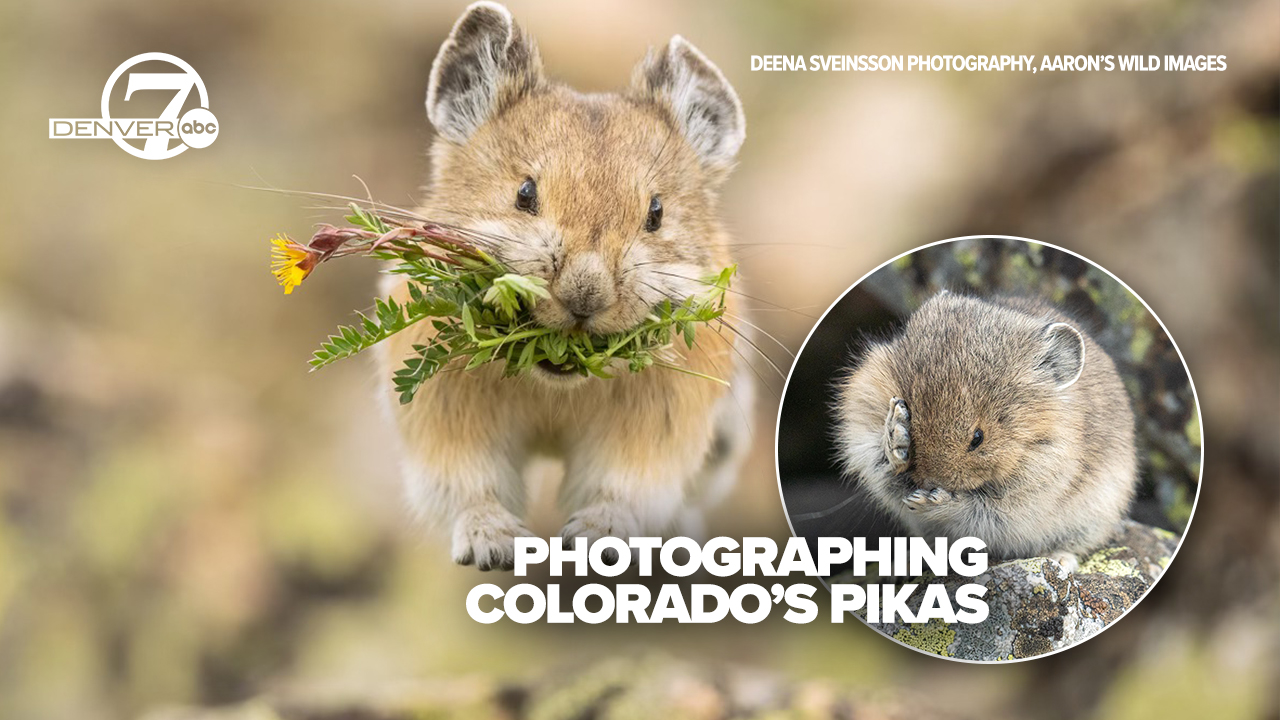ESTES PARK, Colo. — Pikas – small, rabbit-like creatures that live at the higher elevations in the Colorado Rockies – are the subjects of some of the cutest photos you’ll ever see.
For proof, look no further than Denver7’s Discover Colorado | Through Your Photos group on Facebook, where the amazing community of shutterbugs has dropped countless adorable photos of Pikas over the years.
We caught up with two of those photographers, who told us that capturing the many personalities of the little critters is both fun and challenging. They’re both small – about the size of a potato – and have unique habits.
“They’re very fast-moving animals, so trying to predict where they’re going to be in the shot can be very difficult,” said Aaron Cox, the lensman behind Aaron’s Wild Images.
And it’s not just practice-makes-perfect, either. Developing the skill of pika photography is about developing a relationship with the animal.
“If you spend enough time with them and they get to know you, they start feeling more comfortable with you,” said Deena Sveinsson of Deena Sveinsson Photography. “That’s when they allow you to get a little closer and see behaviors they might not show other people.”
Sveinsson captured this writer’s personal favorite pika photo, which shows a fully airborne pika eyeing the camera with a mouthful of flowers in tow.

It’s a photo that took a lot of patience.
“I’ve been trying for years to get this type of photograph to be ground level. A lot of places you can take photos of pikas, you’re looking down on them or they’re quite the distance away,” Sveinsson said. “It’s taken [...] a lot of work, a lot of misfiring, misfocusing, a lot of bad photographs, even ones without pikas in them because they’re so quick.”
Aaron said he’s gone through thousands of photos trying to get certain shots of pikas across Colorado’s mountains.
“I try to catch their personalities – what makes each animal individual,” he said. “Sometimes they’re aggressive, sometimes they’re doing funny things. I want to capture them in certain moods and personalities and show them to the best they can be.”

For Deena, all of the work is not just about capturing photos of a cute and cuddly critter. It’s about making a difference.
“Turning the ordinary into the extraordinary makes me happy,” she said. “When I can introduce somebody to a species or behavior, it’s a rush.”

A passion for pikas
An expertise in pika photography came from very different places for these two.
For Deena, a love of lagomorphs – the zoological term for rabbits, hares and pikas – came first. “It was actually the subjects that drew me into wanting to do photography,” she said.
She’s owned rabbits since she was young. She has two giant continental rabbits, Jackson and Cooper, as pets in her Estes Park home now.

“Because I have that passion, I’m able to spend days and hours out in the weather, in conditions I wouldn’t normally go out in, because I love taking photographs of these animals,” she said.
Aaron, on the other hand, calls photography an “obsession” – but didn’t know what a pika was until a few years ago. It was an intersection of wildlife photography and his other interests in off-roading and hiking that introduced him first to the distinct squeak of the pika, then, with the help of a big lens, to the animal and its habits.
“They’re a very fascinating animal, so it’s been a great journey to learn about them as well as photograph them,” he said.


The state of the pika population
It’s an important time for an awareness campaign, too.
The National Park Service has designated the pika as an “indicator species” to the potential impacts of climate change. Pikas are intolerant to heat and reliant on snowpack, and rising temperatures are negatively impacting their habitat and driving them into higher elevations. The worry is that even Colorado’s highest elevations could become incompatible with pikas’ survival.

Temperature increases are to blame in part for the pika population dwindling in places like California’s Sierra Nevada mountains.
But there’s a group hoping to be a solution. Deena and Aaron have both had involvement with the Colorado Pika Project, which aims to protect the population in Colorado, understand the impacts of climate change and educate the general public about the animal.
The Colorado Pika Project monitors pikas across the state. Users can share photos of pikas to help gather information about where the animals are living in Colorado.
- This story initially aired as part of a Denver7+ special presentation, Discover Colorado: Wildlife stories. Watch the full episode in the video player below:

Colorado’s wildlife photography community
Aaron and Deena travel around the state depending on the subjects they’re after, but both snap many of their photos in Estes Park – Deena’s home town and just a 45-minute drive from Windsor for Aaron – and in Rocky Mountain National Park in particular.
The park is flush with breathtaking scenery and unique wildlife.
“I think a lot of people take Colorado for granted,” Aaron said. “A lot of people I grew up with have never been on Trail Ridge or been down the San Juan Mountains, or even seen half the animals that I photograph. We’ve got people from all over the world that want to see these animals.”
“It’s a pretty fortunate place to grow up and be able to visit.”
And the picturesqueness of our state is a tie that binds photographers.
“The photography community in Colorado is really cool,” Aaron said. “You start meeting people in one place, and then you’ll see them again hours away photographing something totally different. It brings people from all ages and backgrounds together.”






